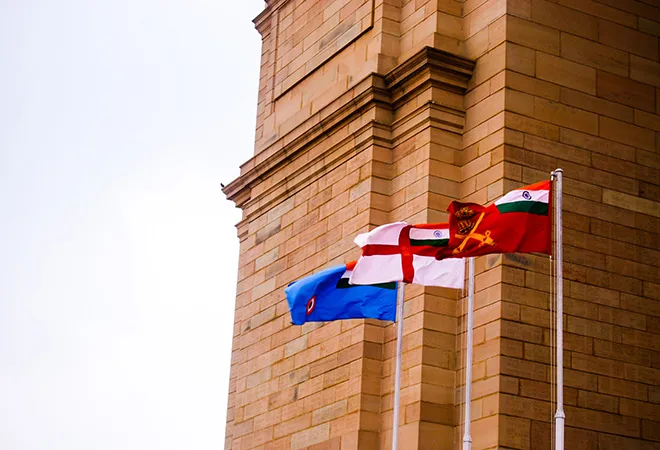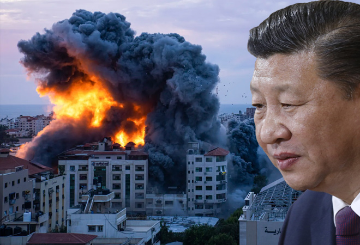
Armed forces across the world are being forced to confront an insidious and deadly foe — the Covid19 virus. In the Pacific, two American super carriers are out of business because of Covid19. With no operational US carriers in the western Pacific, China is flexing its muscles. On Saturday 11 April, the Chinese carrier Liaoning, accompanied by two destroyers and two frigates passed through the Miyako Straits near Okinawa and then turned south-east to pass through the Bashi channel to go to the South China Sea to conduct exercises.
Earlier in mid-March, the PLA Air Force conducted night drills where its fighters simulated an approach towards Taiwan. This was a show of force, aimed as much to the US and Taiwan, as Japan, but also a message that despite the devastation China had suffered, its military was still ready for war. Initially, though the PLA had to cancel its large scale annual joint exercises which are conducted at the huge training range of Zhurihe in Inner Mongolia because of fears that large scale transportation of forces to the range would be too risky.
In any case, the PLA got fully involved in coping with the virus, dispatching 10,000 medical personnel to Wuhan, which also happens to be the headquarters of its Joint Logistics Support Force. These are small and unsettling examples of the ways that conventional ideas and postures on security has been challenged by a pandemic. India, too, needs to keep a sharp eye on the lessons that it could learn from the storm we are currently witnessing.
On 20 March, the first Indian Army jawan to test positive was found, in Leh. A member of the Ladakh Scouts, he had contracted the virus from his father who had picked up the infection from Iran. Subsequently, reports came in about other personnel who were also affected.
The Army has been involved in quarantining operations which have, no doubt, exposed some of its personnel. Among the most vulnerable globally have been the medical personnel. At the end of March a Colonel working in the Army Command Hospital tested positive, as did a Junior commissioned Officer in Dehra Dun. Both infections were linked to Delhi.
Another Army doctor tested positive this week, and others who had been in contact with him and tested positive have been quarantined. Armed forces personnel live in communities —barracks, eat in messes or langars, train and operate in groups. Physical distancing is not easy. Especially in field deployments, say, along the Line of Control, where living accommodation may be in bunkers.
The armed forces have always been a frontline force against natural disasters in the country. In the case of Covid-19, too, when called to duty, the armed forces answered. The Indian Air Force sent in aircraft to provide medical relief to Wuhan and bring back Indian nationals from there and Iran as well. The Indian Army set up a quarantine facility at Manesar and then four more across India to house evacuees from other countries who had to be quarantined.
Even so, the armed forces could not have been unaware of the challenge that was being posed by Covid-19 to their operational posture. To ensure that this is not degraded, the Army moved fast to cancel all non-essential training, conferences and travel, and froe all postings and foreign assignments. Subsequently, similar orders were issued by the Ministry of Home Affairs to cover the paramilitary forces and in addition, it also cancelled all leave of personnel. However, the Army did the opposite and extended the leave of those personnel who were on leave to prevent possible infection from returning jawans and officers.
Air Force bases were also locked down with entry of civilians being restricted. The Indian military operates out of cantonments which were, at least in the past, separated from civilian areas. Faced with Covid-19, the military has more or less sealed themselves off. Access to cantonments is extremely limited and vehicles movement is restricted and in any case, re-entering vehicles are decontaminated. Personnel staying away from bases/ cantonments have been asked to stay out. The Indian military is used to dealing with epidemics and has well-honed procedures and protocols to cope with things like cholera, small pox, malaria, dengue or illnesses like pulmonary edema that afflicted troops being posted to the high mountain areas. Given the nature of the Covid-19 threat, it will no doubt evolve fresh procedures.
Theoretically armies are expected to be able to fight through a nuclear, chemical and biological weapons attack. It is worth asking whether it would have been ready to take on the Covid-19 spread, had it been a deliberate one. Army has equipment like tanks, infantry combat vehicles and helicopters which can operate in a Chemical, Biological, Radiological and Nuclear (CBRN) environment. The Director-General Perspective Planning has a section dealing with issues related to it. The Air Force and the Navy, too have cells dealing with the coping with CBRN issues, which means, operating through CBRN environment — protecting personnel, decontaminating equipment and so on. All three Services carry out periodic exercises to test their response.
But, off-late their focus has been mainly on chemical weapons, which have featured in recent wars. Bio-weapons are still something of out of science fiction, given the difficulty in trying to ensure that – they only strike at the enemy and there is no blowback on those using them. So militaries around the world are not quite prepared for dealing with biohazards. This is reflected in India in the work of DRDO’s premier lab — the Defence Research and Development Establishment (DRDE) in Gwalior. It focused on studies relating to toxicology, dealing with bacterial and viral agents, anthrax and so on, developing medicine kits and clothing for CBRN environments such as decontamination systems, shelters and vehicles.
Some years back, an NBC suit was developed and 50,000 suits and socks were supplied to the Army against an order of Rs 97.87 crore. But the suit is optimized for chemical agents, not viruses. The broad lessons that we can learn immediately from the Covid-19 outbreak are as follows:
- The imperative of digitisation, which is invaluable in ensuring social distancing in hazardous situations such as the one we are undergoing now. Meetings, training courses, education can all be conducted through the digital medium till the threat wanes. Incidentally, the PLA has already launchedan online teaching system to resume classes for foreign cadets in its academies who were forced to return home.
- The need to cater for supply chain disruptions which may arise from a pandemic, as is happening in the case of Covid-19 where railroads, airlines and even road traffic has been blocked off.
- The imperative of mechanization which helps in reducing manpower and hence the impact of pandemics. Of course, a balance has to be struck, on one hand a bio-threat like Covid-19 could call for greater automation and mechanization, but on the other there are cyber and EW threats that electronic equipment and systems of automation are vulnerable to.
- The importance of decentralisation of training and operations to ensure that a pandemic impact can be reduced to manageable hotspots, instead of impacting on large chunks of the force. The key message here is the need for smaller units and redundant structures to spread risks.
The views expressed above belong to the author(s). ORF research and analyses now available on Telegram! Click here to access our curated content — blogs, longforms and interviews.




 PREV
PREV


